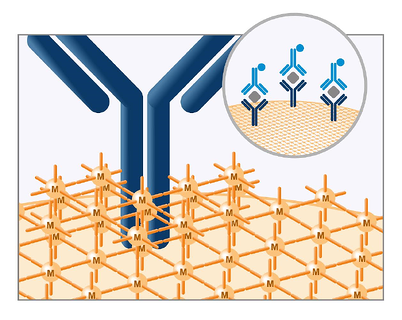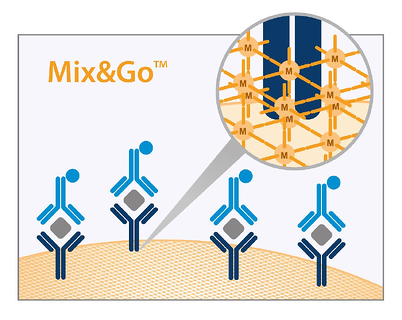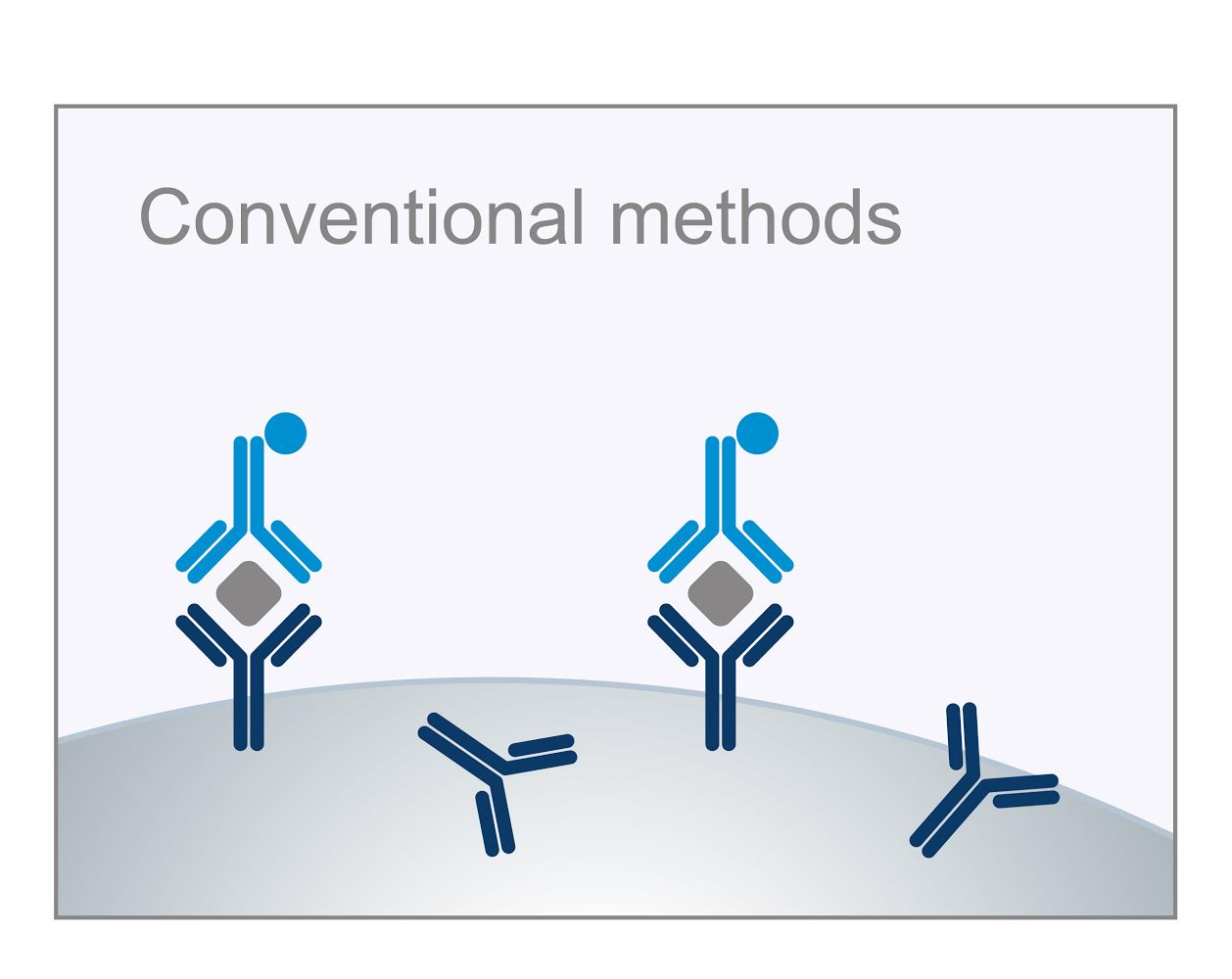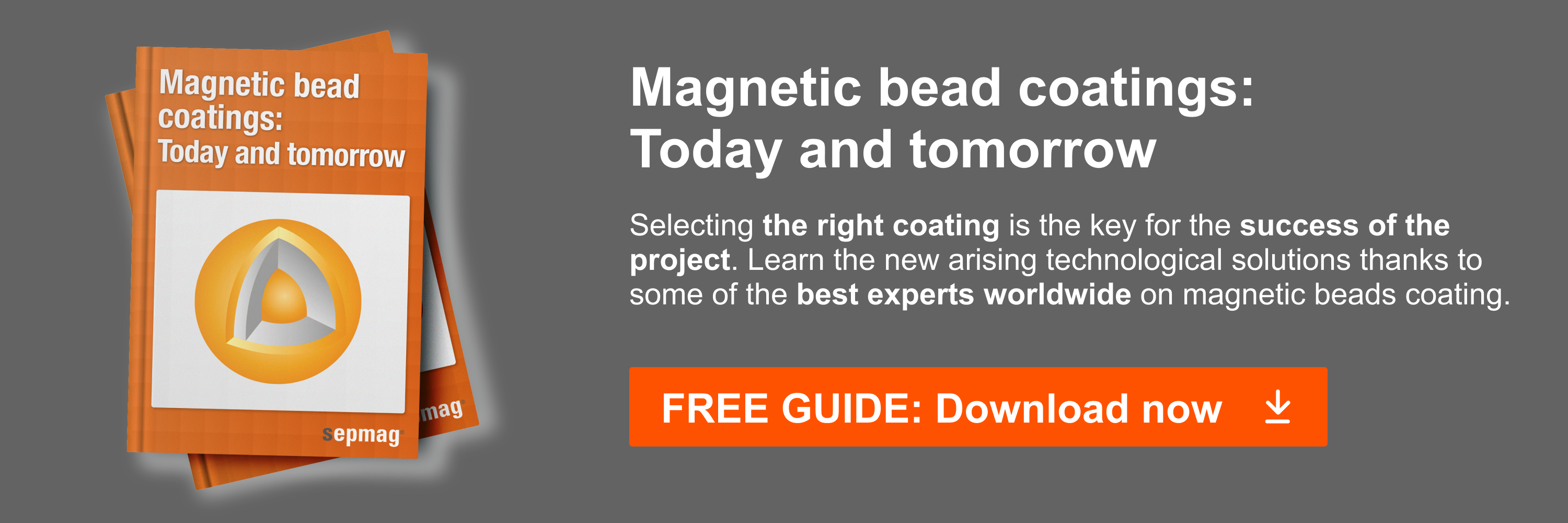Designing binding surfaces with optimal ligand (e.g. antibody, antigen or protein) functionality is required for ultra sensitive assays. However, classical solid phase chemistry approaches for conjugating or binding ligands to surfaces do not control the density or parking area of the ligand, nor do they provide control over ligand conformation and orientation.
In fact, the majority of surface conjugation processes used today such as carbodiimide, tosyl chloride, epoxy, and passive absorption typically input a molar excess of ligand based on the total available surface area and ligand molecular weight and/or hydrodynamic radius (Stokes radius of the macromolecule) to improve process Robustness, Repeatability, and Reproducibility (the 3 R’s).
While this approach will increase total ligand load and theoretical binding capacity, the surface will also be sterically crowded. Moreover, chemistries targeting amino and/or sulfhydryl groups do not necessarily differentiate between available functional groups on the ligand, and subsequently the ligand may be conjugated in a multitude of orientations on the surface depending on the number and location of targeted functional groups. In the case of an antigen down assay, the epitope of interest or binding site(s) may be hidden, and in the case of an antibody down assay the Fab(s) may be unavailable. Since conventional solid phase chemistry approaches to bind ligands may not result in a desired “high sensitivity ” binding surface due to steric hindrance (surface crowding), misorientation, and/or ligand inactivation (no longer in a native or active orientation), there has been a need for new conjugation processes that maximize ligand functionality and actual binding capacity, while improving the 3 R’s.
 If you are interested in magnetic bead coatings, download SEPMAG's newest free guide, Magnetic bead coatings: Today and Tomorrow. You can download it through the following link:
If you are interested in magnetic bead coatings, download SEPMAG's newest free guide, Magnetic bead coatings: Today and Tomorrow. You can download it through the following link:
In 2013, Beckman Coulter, Inc. patented such a process whereby they tightly controlled the spatial and conformational orientation of antigens and antibodies on binding surfaces (Soldo J and Sackrison J. Binding Surfaces for Affinity Assays. U.S. Patent 8,518,714, August 27, 2013). In this patent they teach methods and compositions for non-saturated and non-saturated and orientated binding surfaces for affinity assays utilizing a 3-layer approach of biotinylated BSA (a Poisson distribution of biotin), streptavidin (SA) and biotinylated ligand to control the density of biotin, SA, and immunoglobulins on the surface of microparticles for affinity assays. They demonstrate a significant improvement in assay signal-to-noise and dynamic range for assays (AccuTnI, BNP) using non-saturated and orientated microparticle surfaces as compared to conventional microparticles.
More recently, the group of Philips Research (High Tech Campus, 5656 AE Eindhoven, The Netherlands) published an article that further demonstrates the importance of antibody-capturing activity of antibody-coated nanoparticles (Saha B, Evers T, and Prins M. How Antibody Surface Coverage on Nanoparticles Determines the Activity and Kinetics of Antigen Capturing for Biosensing. Anal. Chem., 2014, 86(16):8158-8166). In this paper, they demonstrate that cardiac troponin I (cTnI) immunoassay response scales with the number of active antibodies, increasing initially but saturating at higher antibody densities. However, in this study the antibodies were nondirectionally immobilized on a nanoparticle surface, and they were not able to fully realize the optimal immunoassay response if the antibodies would have been both non-saturated and orientated.
While Beckman Coulter has developed a specific approach for non-saturated and non-saturated and orientated binding surfaces, this process is patented, and not commercially available. In addition, while Philips Research utilized conventional EDC/NHS carbodiimide chemistry to immobilize antibodies on carboxylic acid functionalized nanoparticles, they were only able to control antibody density and not improve orientation. However, there is novel conjugation chemistry commercially available today using polymeric metal ions based around Cr(III).

Mix&Go™ (Anteo Technologies, Brisbane, Australia) enables the activation of a variety of different surfaces (magnetic and non-magnetic microparticles and nanoparticles, ELISA plates, glass slides, membranes, gold colloids, etc.) for subsequent immobilization of ligands that are non-saturated and functionally active (native conformation). Most recently, metal polymer chemistry has been successfully used to functionalize and bind a variety of antibodies to cyclic olefin copolymers (COC sensor surfaces) for use in assay systems (Ooi H, Cooper S, Huang CY, et al. Coordination complexes as molecular glue for immobilization of antibodies on cyclic olefin copolymer surfaces. Analytical Biochemistry 456 (2014): 6-13).
High sensitivity assays require sterically assessable and conformational active ligand immobilization on the solid phase surface to increase assay signal-to-noise and sensitivity. While classical approaches to ligand conjugation often result in non-optimized binding surfaces due to crowding, conformational change, and/or poor orientation, there are new approaches available today to support the development of ultra sensitive assays such titrating the amount of ligand per unit surface area instead of using molar excess, or metal polymer chemistry by Anteo Technologies. With these new approaches scientists should be able to more readily and efficiently develop the next generation of immunoassays using their test system and surface(s) of choice.
Related articles:
- Magnetic bead coatings: Today and tomorrow
- Rapid biofunctionalization of magnetic beads with function-spacer-lipid constructs
About the author: Joshua Soldo - Anteo Technologies
 VP Scientific Affairs, Anteo Technologies, 8170 Old Carriage Court North, Suite 200, Shakopee, MN 55379 USA, email: joshua.soldo@anteodx.com; phone: +1 612 799 4040.
VP Scientific Affairs, Anteo Technologies, 8170 Old Carriage Court North, Suite 200, Shakopee, MN 55379 USA, email: joshua.soldo@anteodx.com; phone: +1 612 799 4040.
Josh has industry reputation as a subject matter expert in assay development and solid phase chemistry. He was a Senior Scientist at Beckman Coulter from 2001-2007, and Product Development Group Manager for DiaSorin Inc. and Corporate Director Scientific Affairs for DiaSorin S.p.A., from 2007-2014. He joined Anteo Technologies in August 2014 as VP Scientific Affairs.





